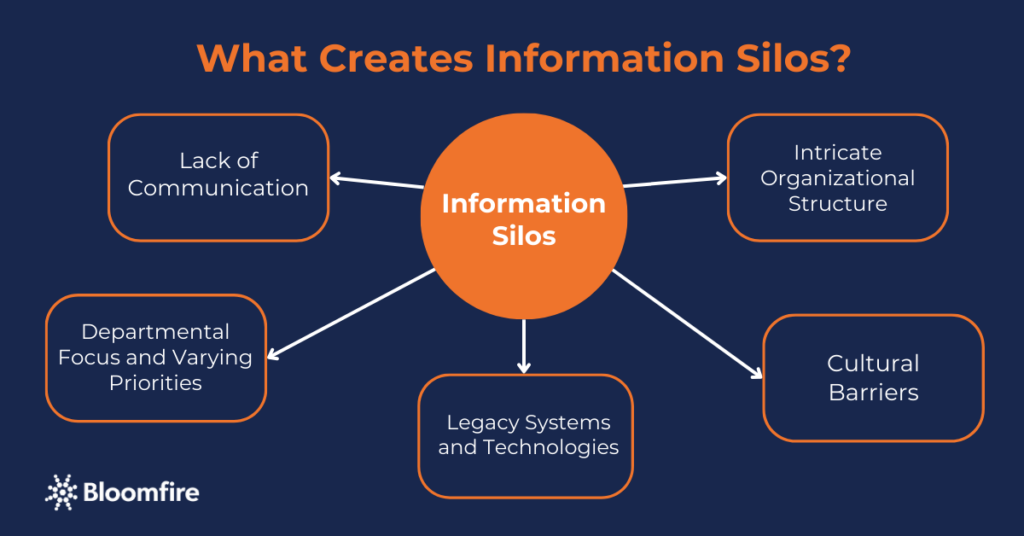What Is an Information Silo and How Can You Avoid It?

In many organizations, valuable knowledge gets stuck in specific teams or departments, creating information silos. When this happens, communication breaks down, collaboration suffers, and business decisions take longer–or worse, are made without the full picture.
Breaking down these silos starts with understanding why they form, what challenges they create, and how to address them effectively. The good news? Building a connected, transparent organization where teams can share knowledge freely and work toward a common goal is possible.
In this guide, we’re answering the question, “What are information silos?” We are also looking at how information silos happen and the steps you can take to prevent or eliminate them.
What Is an Information Silo?
An information silo is an event in which information is contained within one system and cannot connect or communicate with other similar systems. This lack of inter-departmental communication and collaboration leads to the creation of isolated information hubs, known as information silos.
Information silos happen when data is collected and stored in a system that is not or cannot integrate with other technologies and doesn’t exist outside of the system in which it’s currently managed. Think of storage silos on a farm. These structures house grain, feed, woodchips, and other bulk products, keeping them enclosed and protected from the elements. Like a farm silo, they hold data in a standalone, enclosed space.
Examples of Information Silo
What is an information silo in action? It might look like a messy customer relationship management (CRM) with missing or incomplete information, a broken integration between two tools, or multiple tools where you can’t track the stored information. It could also involve forgetting to loop a subject matter expert (SME) into a project, so you’re working with limited knowledge. Consider the following scenarios as situations of information silos.
Scenario 1
A sales team maintains customer data in a separate CRM system while the marketing team uses its database. Consequently, important customer information, such as purchase history or preferences, may not be effectively shared between these departments. It will be challenging for the sales and marketing departments to understand how customers engage with the company at different points of the customer journey.
Scenario 2
Another example of an information silo is when the product team uses a separate project management tool and not sharing updates regularly with other departments. Say the product development team at a software company was working on a new feature, but the marketing team did not have visibility of their progress. This situation led to a misaligned launch campaign that touted features that were not yet ready.
Disadvantages of Information Silo
When information isn’t shared freely, it prevents teams from making the best judgments.
The impact of information silos on businesses can be substantial, particularly in the following ways.
- It impedes efficient decision-making processes. Without access to comprehensive information, managers may struggle to make informed choices, resulting in delays or poor decisions.
- Silos create a fragmented and disjointed work environment. As a result, collaboration and knowledge sharing become difficult.
- It can lead to duplicated efforts and wasted resources. When departments operate independently, they may unknowingly duplicate projects or initiatives completed by another team. This duplication not only wastes time and money but also reduces overall productivity and efficiency.
There may be a few cases where information needs to be siloed (e.g., for security purposes). However, in many cases, siloing knowledge in the workplace generally does more harm than good.
Master Knowledge Management Today!
Prevent information silos by understanding the key strategies to facilitate knowledge sharing.
Read Our Guide
How Do Information Silos Happen?
Silos can arise from a combination of organizational, technological, and cultural factors. They typically develop due to inadequate or outdated technology and processes (or due to a culture of information hoarding). Here are a few common situations that create information silos:

1. Lack of Communication
When different teams or departments within an organization fail to communicate and share information effectively, silos can form. This can happen due to poor internal communication channels, hierarchical structures, or even a lack of awareness about the importance of collaboration.
2. Departmental Focus and Varying Priorities
Organizations with a strong departmental focus often face challenges in sharing information across different teams. Each department may have its own tools, systems, and processes, making it difficult for information to flow seamlessly between them. Managers who are unaware of other departments’ priorities and goals don’t see knowledge sharing as necessary for their efforts.
3. Legacy Systems and Technologies
Outdated or incompatible systems can contribute to the formation of information silos. When different departments rely on disparate technologies that do not integrate well, it becomes challenging to exchange information efficiently.
4. Intricate Organizational Structure
Complex organizational structures, such as multi-tiered management or multiple branches, can create barriers to information sharing. In such cases, information tends to be siloed within specific units, hindering collaboration and knowledge sharing across the organization.
5. Cultural Barriers
Cultural factors, such as a lack of trust, resistance to change, or a competitive environment, can also contribute to the formation of information silos. If employees are not encouraged to collaborate and share knowledge, silos are more likely to emerge.
What Are the Problems Associated With Information Silos?
Information silos aren’t simply inefficient—they can also cause serious problems that may jeopardize the organization’s success. Here are a few things you might experience if you have information silos in your business:
1. Limited Collaboration
When information is isolated and not shared across different departments or teams, it becomes difficult for employees to work together effectively. If teams don’t reach across departmental lines to cooperate on projects or share burdens, they miss opportunities to make everyone’s lives a little easier—and save a lot of time.
Poor collaboration costs businesses valuable time. Nearly two-thirds of employees lose at least three hours of productivity each week due to poor collaboration.
2. Lack of Trust Across Teams
Teams can become wary of each other and feel uncomfortable sharing knowledge because they lack insight into each other’s efforts. Different teams working with various information sets can lead to conflicting outputs, duplicated efforts, and costly mistakes. When these inconsistencies arise, they can lead to finger-pointing and blame, further damaging trust.
In addition, when teams hoard information and operate in secrecy, it creates an environment of suspicion. Other teams may start to wonder, “What are they hiding? Are they working against us?” This lack of transparency fuels doubt and undermines trust.
3. Wasted Time and Resources
When teams can’t access information held by other departments, they often recreate the wheel. This means multiple teams might unknowingly work on the same task, collect the same data, or develop the same solution. This redundancy wastes time, effort, and budget.
Furthermore, employees spend countless hours searching for information hidden within different departments or systems. This time could be better spent on productive tasks contributing to the company’s goals. According to a survey by Gartner, 47% of virtual employees find it challenging to find the information they need to perform their work well.
4. Missed Opportunities for Innovation
Knowledge sharing fosters innovation by combining diverse perspectives and expertise. Whereas silos prevent this cross-pollination, as teams remain unaware of what others are working on, leading to missed opportunities for synergy and creative problem-solving.
One team might possess valuable insights or siloed data that could help another team overcome a challenge or improve a process. However, due to silos, this information remains hidden, hindering progress and potential breakthroughs.
5. Lost Knowledge and Data
When you aren’t sharing information, it’s easy for things to get misplaced or lost entirely. For example, suppose information only exists in one system, and the department that owns it decides to replace that system without migrating all the data. In that case, there’s a good chance some valuable insight will be lost. This also frequently happens when one person is in charge of keeping a set of information and then leaves the organization.
6. Inconsistent or Negative Customer Experience
Suppose you have multiple teams engaging with customers in marketing, sales, and support. If you don’t share information to create one unified approach or share insight into a specific prospect or customers’ needs and pain points, the customer experience becomes unnecessarily complex and disjointed.
Being aware of the consequences of siloed information and knowledge is an excellent first step in promoting knowledge sharing. In addition, you’ll make a sensible case for incorporating a company-wide effort to strengthen inter-departmental collaboration and goal alignment across teams.
How Can You Break Down Information Silos?
Knowing the extent of the problems caused by information silos is not enough to tear it down completely. You’ll need strategies that push for cross-team communication and foster a culture of knowledge sharing. Fortunately, these tactics are not complicated to implement.

1. Establish a Single Source of Truth for Knowledge
Centralize information into one accessible system. Look for a knowledge management platform that integrates with tools employees use daily, such as a CRM or chat platform, so they can access knowledge in the flow of work rather than switching between multiple platforms.
For example, Bloomfire integrations include Slack, Microsoft Teams, Salesforce Lightning, and more. The solution also offers an open API so customers can build connections to other technologies they use.
2. Establish Clear Workflows
Make sure employees know where, when, and how to share information. The more you streamline the knowledge-sharing experience and make it relevant to their efforts, the more likely employees will leverage this solution.
Provide clear guidelines on how information transfer should be done. Allow your SMEs to document the necessary details in a content format appropriate for the topic or type of knowledge.
3. Encourage a Culture of Cross-Functional Collaboration
Employees should feel comfortable working with other teams and departments to solve problems and meet customers’ needs. Encourage cross-departmental collaboration by fostering those working relationships and giving the entire workforce access to a place where they can easily add, update, or request information from each other.
Break down communication barriers to ensure that information flows freely between teams, preventing the formation of silos. This can be achieved through regular team meetings, cross-functional projects, or even informal brainstorming sessions.
4. Measure Progress
The only way to determine the effectiveness of your silo-breaking efforts is to measure progress in areas heavily influenced by information accessibility. To ensure a successful knowledge management implementation, set clear goals, decide which knowledge-sharing metrics you’ll use to measure performance, and get buy-in from the entire organization.
Information silos usually don’t happen because someone is trying to create one—they build slowly over time as organizations onboard new technologies that don’t communicate with others. Invest in a knowledge management solution and ensure your business leaders support knowledge sharing and collaboration to help eliminate existing silos and ensure they don’t occur again.
Replacing Information Silos With Accessible Knowledge
Organizations must prioritize effective communication and collaboration to avoid information silos. Implementing centralized systems and technologies, such as knowledge management platforms like Bloomfire, can help break down silos by providing a centralized repository for information and encouraging cross-departmental collaboration.
Note: This blog post was originally published on Mar 23, 2022. It was most recently expanded and updated in December 2024.
Say Goodbye to Information Silos
Implement a knowledge-sharing platform so employees can easily access and share information.
Check Out Bloomfire

Enterprise AI Search: Definition, Benefits, and Evolution

The Benefit of Company-Wide Knowledge Management in 2026

Are You Making These Common Knowledge Sharing Mistakes?

Estimate the Value of Your Knowledge Assets
Use this calculator to see how enterprise intelligence can impact your bottom line. Choose areas of focus, and see tailored calculations that will give you a tangible ROI.

Take a self guided Tour
See Bloomfire in action across several potential configurations. Imagine the potential of your team when they stop searching and start finding critical knowledge.